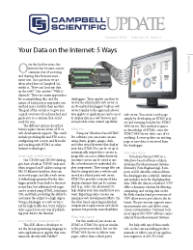The CPEC100 is a closed-path eddycovariance (EC) flux system for long-term monitoring of atmospherebiosphere exchanges of carbon dioxide, momentum, water vapor, and heat. The turn-key system capitalizes on Campbell Scientific’s 15-plus years of developing, manufacturing, and operating atmospheric sampling systems for measuring trace gases. It uses miniature valves mounted on an innovative, custom-designed, compact manifold to perform automatic, on-site zero and span calibrations at the system operating pressure to ensure accurate gas concentration measurements. A CR3000 Micrologger® collects data from the LI-COR LI-7000 CO2 and H2O Analyzer, CSAT3 3-D Sonic Anemometer, and other meteorological sensors. The Micrologger saves all the raw time-series data on a CompactFlash card for later analysis, computes real-time fluxes, and controls the automatic zero and span of the analyzer. A manual water-vapor span is done on site with a dew-point generator. Remote telecommunication options enable monitoring and collecting real-time fluxes and diagnostics.
The CPEC100 draws sample air into the analyzer using an intake tube and diaphragm pump. A critical flow orifice, located at the intake, reduces the pressure in the intake tubing to about half an atmosphere. This reduced pressure increases the flow rate within the intake tubing, improving the system’s response to high-frequency variations of gas concentration and helps ensure accurate flux measurements. The reduced pressure also minimizes condensation within the tubing and reduces the interaction of water vapor with the tubing walls.
Campbell Scientific has been an innovator of micrometeorological measurements since 1980, when we assembled our first datalogger-based open-path eddy-covariance system for measuring evaporation. The CPEC100 is a continuation of our efforts to design and produce quality micrometeorological systems.

